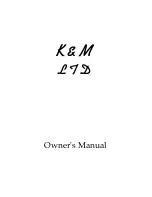
Virtually all the amplifiers on the market are based on a push-pull symmetry model. The push-
pull symmetry topology has no particular basis in nature. Is it valid to use air's characteristic
as a model for designing an amplifier? If you accept that all processing leaves its signature
on the music, the answer is yes.
One of the most interesting characteristics of air is its single ended nature. Sound traveling
through air is the result of the gas equation
PV1.4 = 1.26 X 104
where P is pressure and V is volume, and whose curve is illustrated in fig. 1. The small
nonlinearity which is the result of air's characteristic is not generally judged to be significant at
normal sound levels, and is comparable to the distortion numbers of fine amplifiers. This
distortion generally only becomes a concern in the throats of horns, where the intense
pressure levels are many times those at the mouth, and where the harmonic component can
reach several per cent.
1.0
1.2
1.4
.8
.6
1.0
1.2
1.4
.8
.6
FIG 1 CHARACTERISTIC OF AIR
PRESSURE
VOLUME
(bars)
(M /Kg)
3
Fig. 1 shows the single ended nature of air. We can push on it and raise the pressure an
arbitrary amount, but we cannot pull on it. We can only let it relax and fill a space as it will;
the pressure will never go below "0". As we push on air, the increase in pressure is greater
than the corresponding decrease when we allow air to expand. This means that for a given
motion of a diaphragm acting on air, the positive pressure perturbations will be slightly greater
than the negative. From this we see that air is phase sensitive.
As a result of its single ended nature, the harmonic content of air is primarily 2nd order, that is
to say most of the distortion of a single tone is second harmonic. The phase of this distortion
reflects the higher positive pressure over the negative.
Air's transfer curve also shows also that it is monotonic, which is to say its distortion products
decrease smoothly as the acoustic level decreases. This is an important element that has
often been overlooked in audio design and is reflected in the poor quality of early solid state
Содержание Pass Aleph 60
Страница 1: ...Volksamp Pass Aleph 60 Owner s Manual ...






























